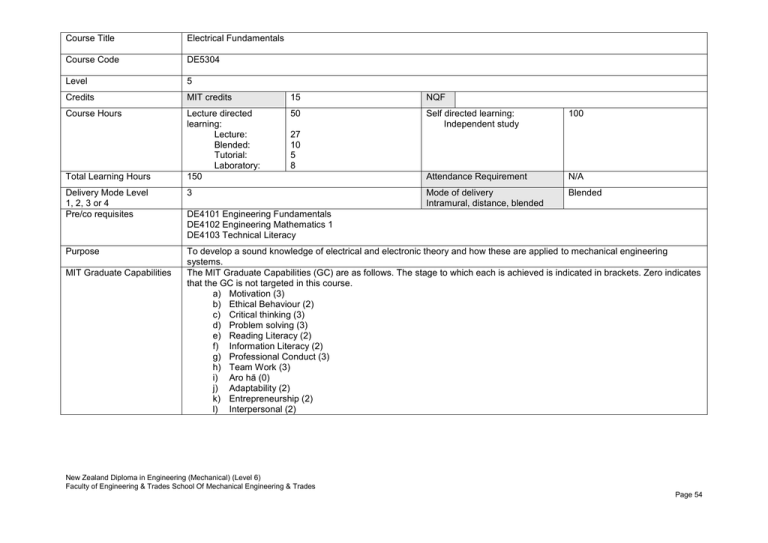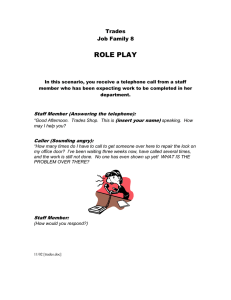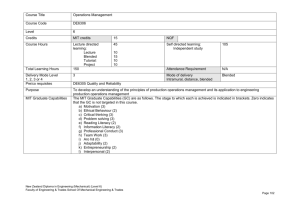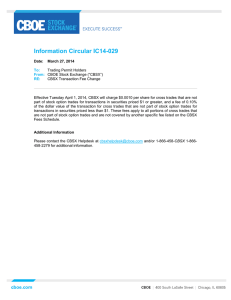Course Title Electrical Fundamentals Course Code DE5304 Level 5
advertisement

Course Title Electrical Fundamentals Course Code DE5304 Level 5 Credits MIT credits 15 NQF Course Hours Lecture directed learning: Lecture: Blended: Tutorial: Laboratory: 150 50 Self directed learning: Independent study 100 Attendance Requirement N/A Mode of delivery Intramural, distance, blended Blended Total Learning Hours 27 10 5 8 Delivery Mode Level 1, 2, 3 or 4 Pre/co requisites 3 Purpose To develop a sound knowledge of electrical and electronic theory and how these are applied to mechanical engineering systems. The MIT Graduate Capabilities (GC) are as follows. The stage to which each is achieved is indicated in brackets. Zero indicates that the GC is not targeted in this course. a) Motivation (3) b) Ethical Behaviour (2) c) Critical thinking (3) d) Problem solving (3) e) Reading Literacy (2) f) Information Literacy (2) g) Professional Conduct (3) h) Team Work (3) i) Aro hā (0) j) Adaptability (2) k) Entrepreneurship (2) l) Interpersonal (2) MIT Graduate Capabilities DE4101 Engineering Fundamentals DE4102 Engineering Mathematics 1 DE4103 Technical Literacy New Zealand Diploma in Engineering (Mechanical) (Level 6) Faculty of Engineering & Trades School Of Mechanical Engineering & Trades Page 54 Learning Outcomes Outline of Content Learning and Teaching Methods LO1 Demonstrate an understanding of the electrical principles commonly required by mechanical engineers relating to DC, AC, and Safety. DC Theory and AC theories: phase angle, power factor, reactance, impedance, single phase and three phase systems and calculations, transformers. Insulation, magnetics, capacitance Interactive learning will be the primary learning method, which will enable one-on-one contact, group work and greater group interaction and cohesion. LO2 Demonstrate an understanding of electrical and electronic components relating to Amplifiers, rectifiers, transducers, DC motors, AC motors. LO3 Demonstrate an understanding of electrical and electronic control systems. Electrical safety, transformers, RCD, double insulation, earthing, fuses, circuit breakers including MCB‟s, and regulations. Basic electronics systems, Amplifiers, rectifiers, inverters, PWM, PLC, micros, PICs. Transducers, Temp, Pressure, Force, acceleration, position, velocity Measurement devices including, voltmeters, ammeters, ohmmeters, energy meters, power factor meters. DC motors and starters, types, characteristics, selection. AC motors and starters, types, characteristics, selection. Power factor correction, speed controllers, stepper motors and drives. Laboratory work will be used to demonstrate the practical component of the course and putting the theory into practice Group work will enable students to engage in class activities encouraging optimal use of the individual‟s preferred learning style while developing the students‟ ability to work together as a team. LMS will be used as an interactive workshop, information repository to enable students to access materials presented in the classroom, and a means of interface between the participants to re-enforce the learning in the laboratory and classroom. Assessment Valid/Reliable Assessment Type Assignments, Tests Laboratory (Practical) Examination Resources Required Text, Web links, Equipment, Computer Labs etc as applicable Weighting Electrical laboratory equipment 20% Outcomes Assessed 1,2,3 30% 1,2,3 50% 1,2,3 Learning commons environment including Digital classroom for group research activities and presentation. Formative Assessment: Feedback is continuous throughout the course with on-line interactive test questions on eMIT, group activities and individual lab progress feedback. This facilitates the opportunity for Q&A and constructive feedback on an ongoing basis. . Students develop their skills throughout the lab session in preparation for their summative assessments Summative Assessment: Lab practical session to assess students‟ ability to measure current, voltage, resistance, energy use, in a simulated safe environment [LO 1-3] Weighting 30% One assignment and one test (written or on-line) on the electrical principles and electrical components. [LO 1-3] Weighting 20% Internet access Electronic resources Electrical safety: http://www.energysafety.govt.n z/templates/MultipageDocume ntTOC____42631.aspx Electrical safety on vector site: http://www.vectorsafety.co.nz/ electrical-safetyworld/index.html You tube on DC circuit http://www.youtube.com/watch ?v=dMQ9Jjmd9V0 You tube on AC circuit: http://www.youtube.com/watch ?v=a2cHVII7lFU Khan academy on circuits: http://www.khanacademy.org/v ideo/circuits--part1?playlist=Physics Digital and analogue systems, standard control signals (i.e. 4New Zealand Diploma in Engineering (Mechanical) (Level 6) Faculty of Engineering & Trades School Of Mechanical Engineering & Trades Page 55 20 mA), Concepts of open and closed loop control, proportional, sequential, LMS will also be used to deliver on-line assignments for students to complete within a given timeframe at their discretion. Tutorials will enable knowledge to be consolidated and clarified. National Set Written Exam to test overall knowledge of the course using detailed explanations. [LO 1,2,3] 50% The student must achieve a min of 40% course work, a min 40% in the exam and an aggregate of 50% to pass the course. New Zealand Diploma in Engineering (Mechanical) (Level 6) Faculty of Engineering & Trades School Of Mechanical Engineering & Trades Page 56





